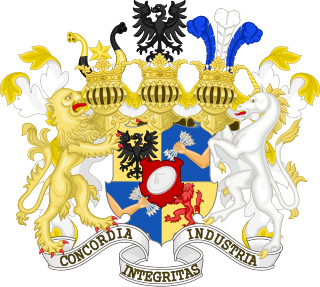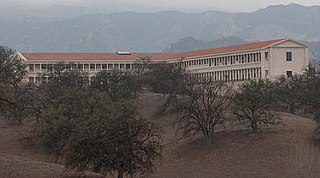
Buthrotum was an ancient Greek and later Roman city and bishopric in Epirus. Inhabited since prehistoric times, Buthrotum was a city of the Greek tribe of the Chaonians, later a Roman colony and a bishopric. It entered into decline in Late Antiquity, before being abandoned during the Middle Ages after a major earthquake flooded most of the city. In modern times it is an archeological site in Vlorë County, Albania, some 14 kilometres south of Sarandë and close to the Greek border. It is located on a hill overlooking the Vivari Channel and is part of the Butrint National Park. Today Bouthrotum is a Latin Catholic titular see.
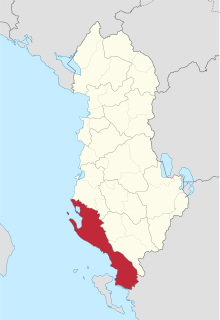
Vlorë County is one of the 12 counties of the Republic of Albania, with the capital in Vlorë. The county spans 2,706 square kilometres (1,045 sq mi) and had a total population of 183,105 people as of 2016. The county borders on the counties of Fier, Gjirokastër, and the Adriatic and Ionian Sea.

Richard Hodges OBE, FSA is a British archaeologist and president of The American University of Rome. A former professor and director of the Institute of World Archaeology at the University of East Anglia (1996–2007), Hodges is also the former Williams Director of the University of Pennsylvania Museum of Archaeology and Anthropology in Philadelphia. His published research primarily concerns trade and economics during the early part of the Middle Ages in Europe. His earlier works include Dark Age Economics (1982), Mohammed, Charlemagne and the Origins of Europe (1983) and Light in the Dark Ages: The Rise and Fall of San Vincenzo Al Volturno (1997).
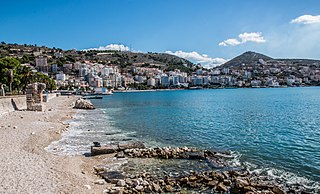
Sarandë, also simply Saranda, is a coastal town in Albania. Geographically, it is situated on an open sea gulf of the Ionian Sea in the central Mediterranean, about 14 km (8.7 mi) east of the northern end of the island of Corfu. Stretching along the Albanian Ionian Sea Coast, Saranda typically has over 300 sunny days a year.

The Kingdom of Albania was established by Charles of Anjou in the Albanian territories he conquered from the Byzantine Empire in 1271. The Kingdom of Albania was declared in late February 1272. The kingdom extended from the region of Durazzo south along the coast to Butrint. A major attempt to advance further in direction of Constantinople failed at the Siege of Berat (1280–1281). A Byzantine counteroffensive soon ensued, which drove the Angevins out of the interior by 1281. The Sicilian Vespers further weakened the position of Charles, and the Kingdom was soon reduced by the Byzantines to a small area around Durazzo. The Angevins held out here, however, until 1368, when the city was captured by Karl Thopia. In 1392 Karl Thopia's son surrendered the city and his domains to the Republic of Venice.

The Albanian art refers to all artistic expressions and artworks in Albania or produced by Albanians. The country's art is either work of arts produced by its people and influenced by its culture and traditions. It has preserved its original elements and traditions despite its long and eventful history around the time when Albania was populated to Illyrians and Ancient Greeks and subsequently conquered by Romans, Byzantines, Venetians and Ottomans.

The Butrint National Park is a national park in southern Albania, located 18 kilometres (11 mi) south of Sarandë in Vlorë County. The park encompasses 9,424 hectares (94.24 km2) of hilly terrain with freshwater lakes, wetlands, salt marshes, open plains, reed beds and islands. The park’s significance for conservation is reflected in the large number of species with over 1,200 different animals and plants. Its mandate includes the protection of the lake and lagoon of Butrint, the natural channel of Vivari, the islands of Ksamil and as well the archaeological site, that provides valuable remains of ancient civilizations.

Delvinë is a town and a municipality in Vlorë County, southern Albania, 16 kilometres northeast of Saranda. It was formed at the 2015 local government reform by the merger of the former municipalities Delvinë and Vergo, that became municipal units. The seat of the municipality is the town Delvinë. The total population is 7,598, in a total area of 182.90 square kilometres. The population of the former municipality at the 2011 census was 5,754.

Phoenice or Phoenike was an ancient Greek city in Epirus and capital of the Chaonians. It was also the location of the Treaty of Phoenice which ended the First Macedonian War, as well as one of the wealthiest cities in Epirus until the Roman conquest. During the early Byzantine period, Phoenice was the see of a bishopric. The city is an archaeological park of Albania and is located on a hill above a modern town which bears the same name, Finiq, in modern southern Albania.
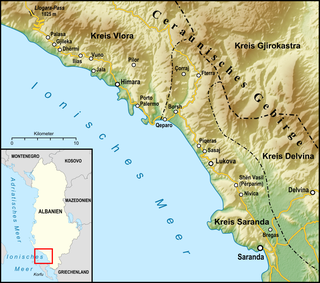
The Albanian Riviera, also popularly known as Bregu, is a coastline along the Northeastern Ionian Sea in the Mediterranean Sea encompassing the districts of Sarandë and Vlorë in Southwestern Albania. It forms an important section of the Albanian Ionian Sea Coast dotted with the villages of Palasë, Dhërmi, Vuno, Himara, Qeparo, Borsh, Piqeras, Lukovë and Sarandë.
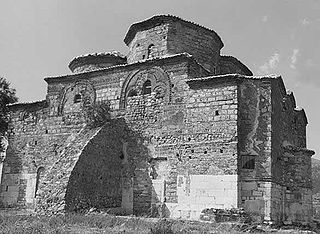
St. Nicholas Monastery Church is the katholikon of the abandoned Orthodox monastery of Saint George in Mesopotam, Vlorë County, Albania.
Sir Patrick Fairweather is a British retired diplomat. He served as Ambassador to Angola from 1985 to 1987 and Ambassador to Albania from 1991 to 1996. He was director of the Butrint Foundation of the Buthrotum Roman archaeological site in southern Albania from 1997 until 2004.
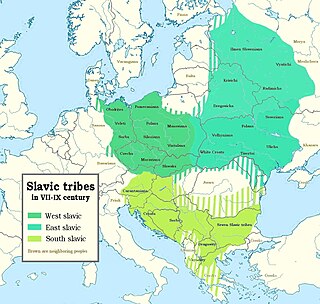
The Baiounitai or Vayunites were a Sclaveni tribe which settled the region of Macedonia at the end of 6th century. The Baiounitai initially settled region west of Thessalonica. They belonged to a group of Slavic tribes that unsuccessfully tried to capture the city at the beginning of the 7th century, after which they are believed to have migrated to the region of northern Epirus, between Ioannina in Greece and Himara in modern Albania.
Athanasius I (1560–1616) was the Archbishop of Ohrid from 1596 to 1598. He was known for protecting the Macedonian Slavs from Ottoman tyranny. He was born in the Mani Peninsula in southern Greece, as Athanasios Rizeas. He organized the failed Himara Revolt against the Ottoman Empire.

The Architecture of Albania is a reflection of Albania's historical and cultural heritage. The country's architecture was influenced by its location within the Mediterranean Basin and progressed over the course of history as it was once inhabited by numerous civilisations including the Illyrians, Ancient Greeks, Romans, Byzantines, Venetians, Ottomans as well as modern Austro-Hungarians and Italians. In addition, missionaries, invaders, colonisers and traders brought cultural changes that had a large profound effect on building styles as well as techniques.
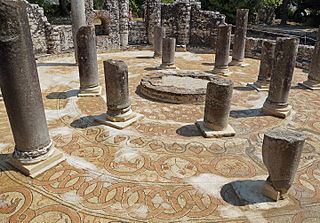
The baptistery at Butrint, an archeological site in Vlorë County, Albania and part of the Butrint National Park, is a late antique structure known for its well-preserved mosaic pavement. The centrally planned, circular baptistery is also notable as an ancient Roman monument adapted to the needs of Christianity.
Philippa Mary Pearce is a senior conservator at the British Museum. She is particularly known for her work on coin hoards found in England and was awarded an MBE for services to metal conservation in 2018. She has worked on most of the coin hoards found in recent years as part of the Treasure process.
